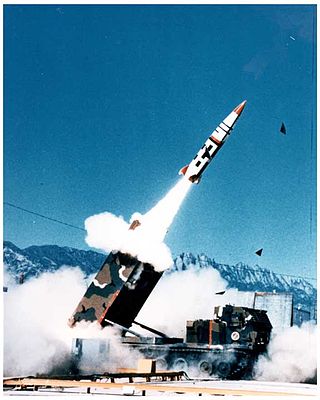
A missile is an airborne ranged weapon capable of self-propelled flight aided usually by a propellant, jet engine or rocket motor.

The MGR-1 Honest John rocket was the first nuclear-capable surface-to-surface rocket in the United States arsenal. Originally designated Artillery Rocket XM31, the first unit was tested on 29 June 1951, with the first production rounds delivered in January 1953. Its designation was changed to M31 in September 1953. The first Army units received their rockets by year's end and Honest John battalions were deployed in Europe in early 1954. Alternatively, the rocket was capable of carrying an ordinary high-explosive warhead weighing 1,500 pounds (680 kg).

A tactical ballistic missile (TBM), or battlefield range ballistic missile (BRBM), is a ballistic missile designed for short-range battlefield use. Typically, range is less than 300 kilometres (190 mi). Tactical ballistic missiles are usually mobile to ensure survivability and quick deployment, as well as carrying a variety of warheads to target enemy facilities, assembly areas, artillery, and other targets behind the front lines. Warheads can include conventional high explosive, chemical, biological, or nuclear warheads. Typically tactical nuclear weapons are limited in their total yield compared to strategic nuclear weapons.

The People's Liberation Army Rocket Force, formerly the Second Artillery Corps, is the strategic and tactical missile force of the People's Republic of China. The PLARF is the 4th branch of the People's Liberation Army (PLA) and controls China's arsenal of land-based ballistic, hypersonic, cruise missiles—both nuclear and conventional. The armed service branch was established on 1 July 1966 and made its first public appearance on 1 October 1984. The headquarters for operations is located at Qinghe, Beijing. The PLARF is under the direct command of the Chinese Communist Party's Central Military Commission (CMC).

The MGM-52 Lance was a mobile field artillery tactical surface-to-surface missile system used to provide both nuclear and conventional fire support to the United States Army. The missile's warhead was developed at Lawrence Livermore National Laboratory. It was replaced by MGM-140 ATACMS, which was initially intended to likewise have a nuclear capability during the Cold War.

The Fajr-3 is an Iranian heavy 240 mm intermediate-range multiple-launch artillery rocket (MLRS). The Fajr-3 is a license-built copy, with slight modifications, of a North Korean MLRS called the M-1985. The Fajr-3 was introduced in the 1990s and has since been exported to Hamas and Hezbollah.

The Korean People's Army Strategic Force, previously known as the Korean People's Army Strategic Rocket Force, is a military branch of the Korean People's Army (KPA) founded in 2012 that operates surface-to-surface missiles in the nuclear and conventional strike roles. It is mainly armed with ballistic missiles. The inventory includes domestic and Soviet designs.

The MGR-3 Little John was a free flight artillery rocket system designed and put into service by the U.S. Army during the 1950s and 1960s.
The Nasr, is a solid fueled tactical ballistic missile system developed by the National Development Complex (NDC) of Pakistan, currently in service with the Pakistan Army.

Prahaar ("Strike") is an Indian solid-fuel road-mobile tactical ballistic missile developed by the Defence Research and Development Organisation (DRDO). Prahaar is expected to replace the Prithvi-I short-range ballistic missile in Indian service.
The Hwasong-13, also known as Nodong-C or KN-08 under the U.S. naming convention, is a road-mobile intercontinental ballistic missile believed to be under development by North Korea. The changes shown in the mock-up displayed in October 2015 indicated a change from a three- to two-stage design.
The Pukguksong-1 or Pukkŭksŏng-1, Bukgeukseong-1, alternatively KN-11 in intelligence communities outside North Korea, is a North Korean, two-stage submarine-launched ballistic missile (SLBM) that was successfully flight tested on 24 August 2016.

The Ure, often called KTSSM is a short-range tactical surface-to-surface missile (SSM) developed through the Lightning Project that began as a countermeasure against North Korea's conventional artillery raised in the wake of the Bombardment of Yeonpyong Island.
KN-23, officially the Hwasong-11Ga 《화성-11가》형 is a designation given to a North Korean solid-fueled tactical ballistic missile.

KN-24, officially the Hwasongpho-11Na, is a designation given to a North Korean single-stage, solid-fueled tactical ballistic missile.
The Hwasong-17 is a North Korean two-stage ICBM, first unveiled on 10 October 2020, at the 75th anniversary of the founding of the Workers' Party of Korea (WPK) parade. The Japanese Ministry of Defence estimates its operational range at 15,000 km or more. Unlike its predecessors, the Hwasong-17 may be capable of carrying multiple warheads. North Korea claimed the first Hwasong-17 was successfully launched on 24 March 2022. Western analysts instead believe the 24 March launch was an earlier missile design, and a later test that took place on 18 November 2022 was the first successful test launch.

The 2021–2023 North Korean missile tests are a series of North Korean missile tests in 2021, 2022, and 2023. North Korea conducted a record number of tests in 2022, including the first test over Japanese territory since 2017.
The Hwasong-8 is a North Korean missile claimed to be mounting a hypersonic glide vehicle, which was first tested on 14 September 2021. The first launch occurred in September, a month with a total of four missile launches. As it is supposedly a hypersonic missile, the higher speed would allow it to reach its target in shorter time and additional maneuverability would give it a better chance at defeating missile defenses. Japanese tracking data from a test launch suggest it is a hypersonic ballistic missile, as North Korea described it.











